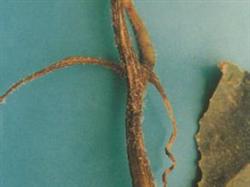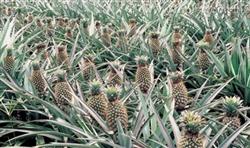Opinions on production management of cantaloupe in greenhouse at present

First, the specific cultivation measures of the plants entering the extension period are as follows: 1, traction and binding vines. The traction and binding of the vine can begin when the plant grows to more than 6 or 7 nodes, but the traction rope should be set up in time before the vine is extended to facilitate the plant to wrap around the vine. 2. Pruning and pruning. When the plant enters the extension stage, the stem vine extends rapidly, so it should be pruned in time, and all the lateral vines under 12 nodes should be removed to reduce nutrient consumption. If necessary, stem coating can be used to improve the disease control effect. 3. Spraying borax. When the plant grows to about 1 meter, it is sprayed with 0.1%-0.2% borax leaf surface once to promote fruit-setting 4 and greenhouse temperature regulation: the temperature in the greenhouse is high in autumn, the greenhouse should be ventilated and cooled, and there is no rainstorm, typhoon and other weather, and the skirt can be rolled up all the time. 5. the appearance of the shed is clean. Weeds inside and outside the greenhouse should be cleaned up in time to reduce the breeding grounds for diseases and insect pests. 6. The ditch system is unobstructed. Keep the peripheral ditch and shed ditch clean to ensure that the drainage of the ditch system is smooth during the rainstorm, and the groundwater level is too high, which will lead to difficulty in fruit setting and premature senility in the later stage. Second, the specific cultivation measures of the plants entering the flowering and pollination stage are as follows: 1. Artificial pollination. At present, some fields have entered the period of pollination, so artificial pollination should be carried out at 6: 10 a.m., the male flowers blooming on different plants of the same variety should be selected, the petals should be broken off, and the stamens should be evenly and gently smeared on the female flower stigma. In order to improve the safety and hygiene of melons and fruits and improve the merchandise of melons and fruits, the use of Ziguoling is not recommended. 2. Keeping fruit and thinning fruit. More than 12 nodes and 4-5 consecutive lateral vines with female flowers were selected. the lateral vines with female flowers were left with two leaves for tip removal, and all the other lateral branches were removed. When the fruit grows to the size of an egg a week after pollination, choose to leave one fruit. Leave a melon on a single vine. Third, the prevention and control of diseases and insect pests should implement the comprehensive control principle of giving priority to prevention and combining agricultural control with chemical control. Through reasonable pruning and fruit retention, scientific fertilization, controlling the humidity in the greenhouse, keeping the ground and air dry in the greenhouse, reducing the occurrence and spread of diseases. At the same time, observation and inspection should be strengthened and chemical protection should be carried out in the early stage of the disease to ensure the normal growth of cantaloupe. 1. At present, the main diseases of Hami melon in greenhouse are vine blight, virus disease, powdery mildew and so on. Recommended medicament: vine blight can be treated with 64% disinfectant alum wettable powder plus 50% methyl topper wettable powder Jin Jia agricultural streptomycin into a paste coating stem treatment to control the continued development of the disease. Virus diseases can be prevented with drugs such as Shengkeduke (8% Ningnanmycin water), virus removal, and so on. Note: if you find virus-infected plants, do not immediately contact the diseased plants, should wait until the end of all agricultural work, ready to leave the greenhouse, then pull out the diseased plants and take them out of the greenhouse. 2. At present, the main pests of cantaloupe in greenhouse are aphids, melon silk borer, Bemisia Tabaci and so on. The control methods are as follows: recommended medicament: aphids: sprayed with 10% imidacloprid wettable powder, etc.; melon silk borer: sprayed with 1% avermectin, etc.; Bemisia Tabaci: spray control with 70% amyl water dispersible granules, 25% Aketai water dispersible granules, etc. 3. For the fields that already have fruit branches, combined with insect spray, 10% Shigao moisture dispersible granules should be added to prevent powdery mildew (40% Fuxing EC is not recommended at this stage, mainly used in the middle and later stages). The rest can be prevented comprehensively with 50% methyl thiophanate wettable powder or 70% chlorothalonil wettable powder.
- Prev

Cultivation and management techniques for high yield and high quality of pineapple
First, selected and prepared pineapple is a tropical crop, which is warm, moist, soft and fertile, while afraid of frost, drought, stickiness and barren. The county has a tropical climate and is the most suitable ecological area for pineapple growth. When arranging the planting of pineapple, it is appropriate to choose deep, soft, moist and organic soil.
- Next

Spring cultivation techniques of cantaloupe in greenhouse
Cantaloupe is favored by the general public because of its rich nutrition, sweet taste, cool summer heat and other effects. Since 2002, with the technical support of Wu Mingzhu, academician of * * Hami Melon Research Center, Hami melon has been successfully introduced, demonstrated and popularized in Jiading District, and Hami which is more suitable for the climatic characteristics of the southern region has been selected.
Related
- Moge, come on! The staff of the peasant association in the producing area of cantaloupe were frightened when the crowd gathered.
- Causes and Solutions of low Fruit setting rate of Apple
- Symptoms and control measures of passion fruit virus disease
- Fruit growing lesson: how do apple orchards keep high yields?
- Can you build orchards in the mountains? What are the pros and cons?
- How to manage the coloring period of Crisson grape?
- This paper introduces the processing technology of two kinds of fig products.
- How much is a month for retired teachers in rural areas by 2020?
- How can strawberry planting increase sugar content? We should pay attention to management in many aspects.
- What are the cultivation techniques on how to improve the yield of golden fruit?

